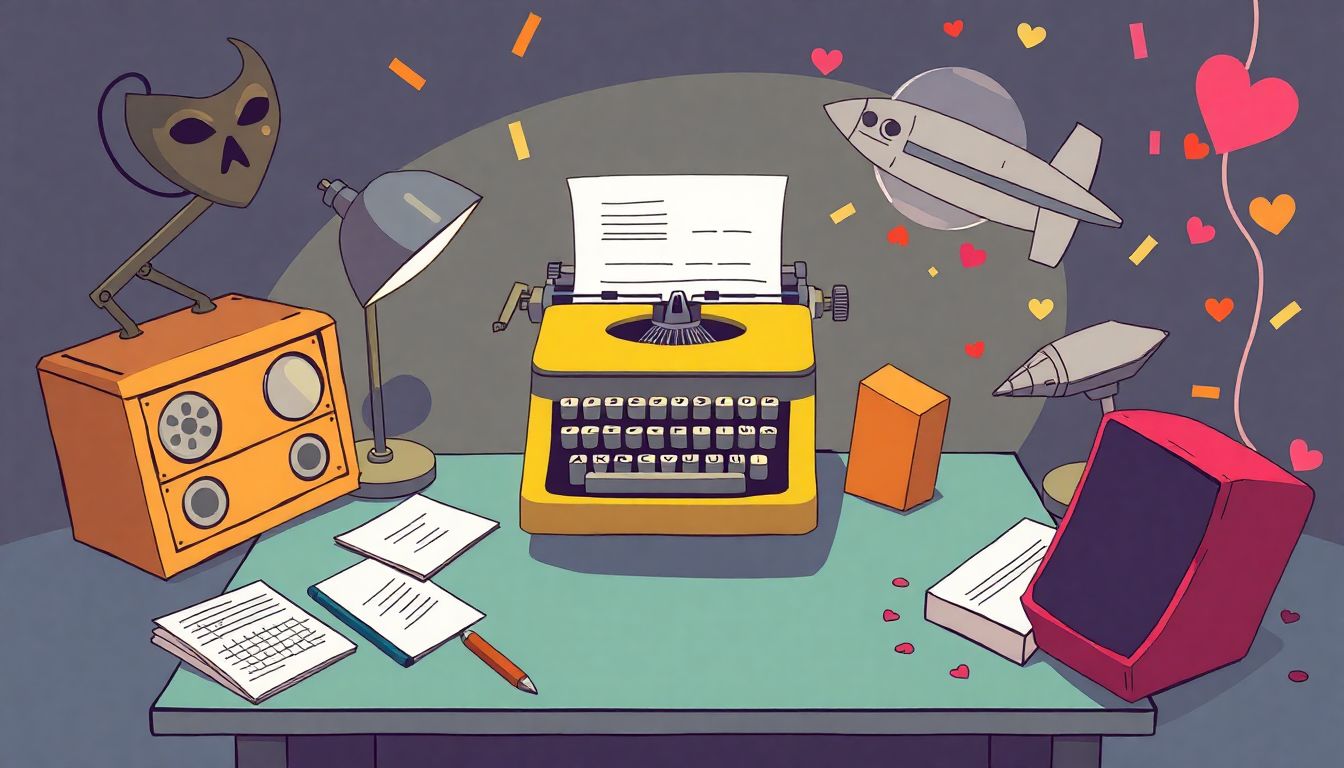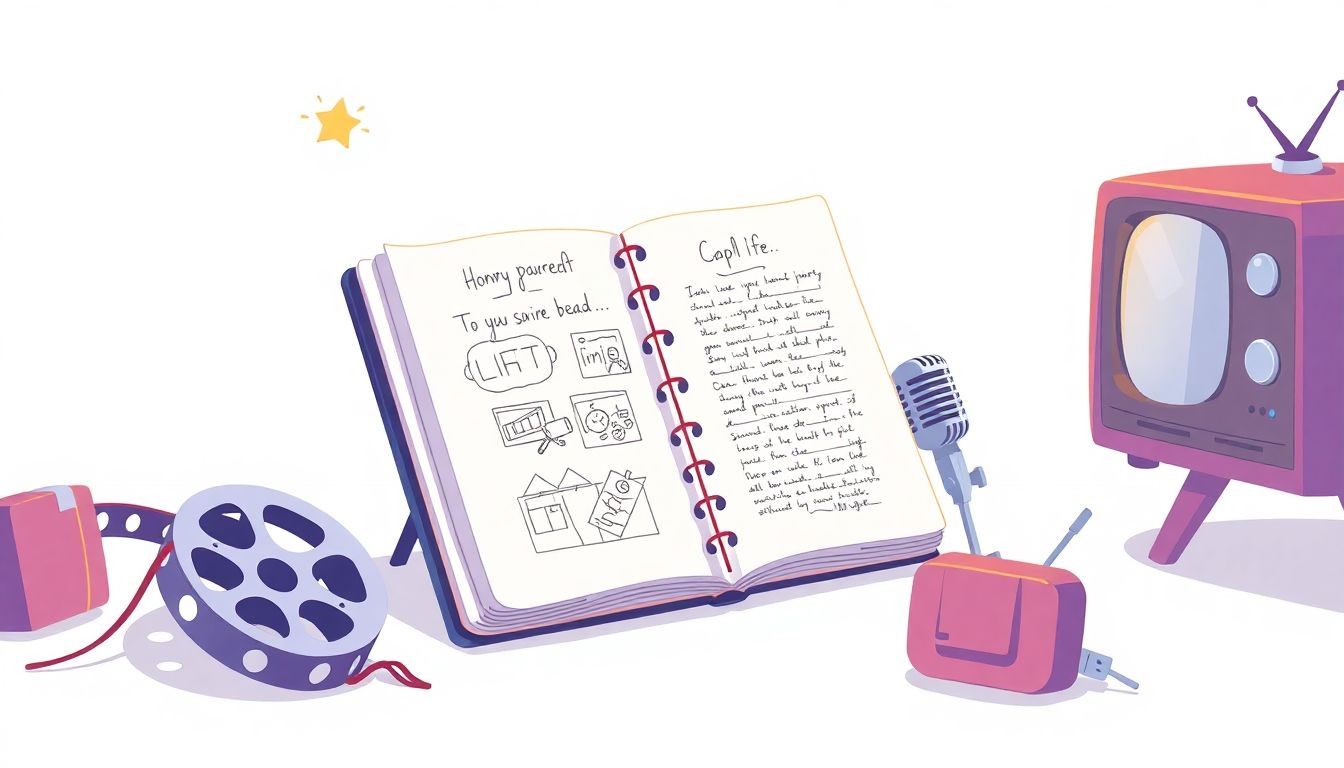Creating parody video scripts can be a fun yet challenging endeavor. You might find yourself staring at a blank page, struggling to come up with ideas that are both funny and engaging. It’s easy to feel overwhelmed when trying to strike the perfect balance between humor and creativity, right?
But don’t worry! If you stick around, I’ll share some fantastic prompts and tips to help you craft hilarious parody scripts with the help of ChatGPT. Whether you’re a seasoned creator or just starting, these insights will unlock the comic potential in your ideas.
From catchy titles to popular themes, we’ll explore everything you need to make your parody videos stand out. Let’s dive into the world of laughter and creativity together!
Key Takeaways
- Parody video scripts combine humor and creativity; using prompts can spark great ideas.
- Try prompts like parodying movie scenes or creating satirical news reports to inspire scripts.
- Utilize ChatGPT by inputting clear themes and ideas to generate funny scripts tailored to your audience.
- Catchy titles boost views; use wordplay, alliteration, and keep them short for maximum impact.
- Identify popular parody themes like reality TV or viral music to stay relevant and engaging.
- Customize prompts for different genres to better capture their unique comedic styles.
- Editing and refining scripts enhances humor; focus on punchlines, timing, and flow for polish.

Best ChatGPT Prompts for Parody Video Scripts
If you’re diving into the world of parody video scripts, having the right prompts can be a game changer. Here’s a list of prompts designed to spark creativity and humor in your scripts.
- Create a parody of a popular movie scene, replacing serious dialogue with humorous twists.
- Write a satirical news report about a trending topic, using exaggerated character traits.
- Transform a well-known song into a funny love letter from a pet’s perspective.
- Imagine a conversation between two famous characters in an absurd situation.
- Develop a fictional product commercial that humorously exaggerates everyday problems.
These prompts can help kickstart your script and encourage a comedic tone. Don’t hesitate to customize them further based on your audience!
How to Use ChatGPT to Create Funny Parody Scripts
Using ChatGPT for parody script writing is straightforward and fun! Start by brainstorming your main idea or theme. Decide what you want to parody—be it a movie, song, or a trending topic.
Next, input your idea into ChatGPT as a prompt. For example: “Generate a funny parody script about [main idea].”
You can also specify style or tone: “Write a humorous take on [movie name] focusing on [specific aspect].”
Experiment with different requests to refine your output. If you need more, try asking for alternative takes on a scene or character reactions to absurd events.
As you create, keep in mind the comedic structure: setup, conflict, and punchline. ChatGPT can provide you with different ideas for punchlines, so feel free to ask for more specific jokes or sarcastic lines.
Tips for Writing Catchy Parody Video Titles with ChatGPT
The title of your parody video plays a huge role in grabbing attention. Use ChatGPT to brainstorm catchy titles that entice viewers. Start with a clear indication of your parody subject.
Try prompts like: “Generate funny titles for a parody of [specific movie/song].”
Here are a few title crafting tips:
- Incorporate puns and wordplay related to the original content.
- Use alliteration or rhyming to enhance memorability.
- Keep it short and snappy to engage viewers quickly.
For inspiration, type: “Suggest parody titles that include humor and irony related to [topic].”
Remember, a good title can make the difference between a click and a scroll.
Examples of Popular Parody Themes to Try with ChatGPT
Parody themes are vast and can range from pop culture references to societal commentary. Here are some popular ones you might consider:
- Reality TV shows: Satirize the absurdity of reality competitions.
- Music videos: Create a spoof of a viral music hit, focusing on the trends it embodies.
- Movies: Put a comedic spin on classic films, focusing on their clichés.
- Social Media Trends: Make fun of viral challenges or internet fads.
- Commercials: Create exaggerated mock ads for common products.
You can prompt ChatGPT with: “List popular parody themes in current media.” This can help you stay aligned with trends while brainstorming ideas.

How to Tailor ChatGPT Prompts for Different Genres of Parody
Crafting parody scripts for different genres requires tailored prompts to match the unique tone and style of each genre.
Start by identifying the genre you want to focus on, such as horror, sci-fi, or romantic comedy.
For horror parodies, use prompts like: “Create a scary movie parody featuring over-the-top characters behaving absurdly.”
If you’re interested in sci-fi, try: “Write a parody about aliens misunderstanding human technology.”
For a romantic comedy, you might say: “Generate a funny script about a disastrous blind date that turns into an epic fail.”
By specifying the genre in your prompt, you allow ChatGPT to draw on genre-specific tropes and clichés, enhancing the humor.
Don’t hesitate to mix genres! For example, prompt it with: “Write a horror movie parody that incorporates rom-com elements.”
This approach broadens your creative landscape and can lead to unexpected and hilarious results!
Step-by-Step Guide to Crafting a Parody Script Using ChatGPT
Creating a parody script can be an enjoyable and structured process with ChatGPT.
First, choose your source material. Let’s say you pick a popular movie or song.
Formulate a prompt, starting with: “Generate a parody script based on [source material].”
Next, define the tone you want to achieve. For example: “Make it light-hearted and absurd.”
Once you receive your first draft, review it critically. Identify the setups, conflicts, and potential punchlines.
Use a follow-up prompt to improve it: “Add more sarcasm to the dialogue,” or, “Include a funny twist at the end.”
After you refine the script, read it aloud to gauge if the punchlines land effectively.
Consider using prompts like: “Suggest alternative jokes for this scene,” to spice things up further.
Finally, organize the script into clear scenes, ensuring smooth transitions that enhance comedic timing.
Common Mistakes to Avoid When Using ChatGPT for Parody Scripts
While ChatGPT is a powerful tool, it’s easy to stumble into some common pitfalls when writing parody scripts.
One major mistake is creating vague prompts. Prompt with specific references, like: “Parody the dialogue from [specific scene] with a humorous twist.”
Another error is failing to maintain a comedic structure. Use prompts that remind you of the setup, conflict, and resolution, e.g., “Outline a 3-act structure for a twist on [original work].”
Also, don’t overlook character consistency. Rather than changing character personas randomly, specify traits in prompts: “Make the character overly dramatic about mundane situations.”
Be cautious with cultural references. Ask ChatGPT: “Can you avoid outdated references in this parody?” to keep it relatable.
Lastly, review and edit the output closely! Use prompts such as: “List areas that need more humor,” to spark improvement ideas.
How to Edit and Enhance ChatGPT Generated Parody Scripts
Editing is where a decent parody becomes a great one. Start by reviewing the generated script for flow and pacing.
Use prompts like: “Identify any awkward transitions and suggest smoother alternatives.”
Next, focus on punchlines. Look for areas that feel flat and prompt: “Generate ten alternate punchlines for this setup.”
Incorporate feedback from friends or peers; ask ChatGPT: “What dialog improvements can make this character sound funnier?”
Don’t forget to adjust timing! Comedy relies heavily on how jokes land. Use prompts like: “How can I introduce pauses to enhance humor in this scene?”
Lastly, ensure your parody retains its voice throughout. Insert prompts that check for consistency: “Does this dialogue match the tone established in the beginning?”
Fine-tuning will elevate your script, turning it into a must-watch parody video!

Resources for Inspiration When Creating Parody Content
Finding inspiration for your parody content can be fun and rewarding. Start by exploring popular media and current events. Look at trending shows, songs, or viral videos to see what’s capturing people’s attention.
Utilize classic parody sites like Saturday Night Live or Mad TV as benchmarks for style and timing.
You can also follow comedians and humorists on social media for a fresh perspective on topical humor.
Try using prompts like:
- “List current events suitable for parody.”
- “Provide popular catchphrases that can be used humorously.”
- “Suggest iconic scenes from movies that need a comedic twist.”
Additionally, check out online forums or communities dedicated to parody writing such as Reddit’s r/Comedy or writing groups on social media.
Documentaries and interviews with comedians can give you insights into their creative process and comedic timing.
Also, explore literature or classic jokes for inspiration. Consider how a timeless tale, like a fairy tale, could be transformed into something absurd or clever.
Lastly, remember that real-life scenarios and your own experiences can also provide a wealth of material. Keep a notebook handy to jot down funny ideas or situations you encounter daily.
FAQs
Effective prompts include specific themes, genres, and character roles. For example, ask for a parody of a popular song, movie, or TV show, and specify a humorous twist or theme for the best results.
To enhance your script, focus on editing for punchlines, pacing, and rhythm. Add personal touches and unique references, and consider giving feedback to ChatGPT for more tailored outputs that better match your vision.
Avoid vague prompts and failing to provide context, as they can lead to uninspired results. Also, steer clear of going too far with satire, which may render your parody ineffective or offensive.
Seek inspiration from current trends, pop culture, classic literature, and social media. Popular songs, viral videos, and well-known movies are also excellent sources for parody themes that resonate with viewers.
